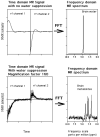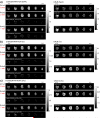Research applications of magnetic resonance spectroscopy to investigate psychiatric disorders
- PMID: 19363431
- PMCID: PMC2669689
- DOI: 10.1097/RMR.0b013e318181e0be
Research applications of magnetic resonance spectroscopy to investigate psychiatric disorders
Abstract
Advances in magnetic resonance spectroscopy (MRS) methodology and related analytic strategies allow sophisticated testing of neurobiological models of disease pathology in psychiatric disorders. An overview of principles underlying MRS, methodological considerations, and investigative approaches is presented. A review of recent research is presented that highlights innovative approaches applying MRS, in particular, hydrogen MRS, to systematically investigate specific psychiatric disorders, including autism spectrum disorders, schizophrenia, panic disorder, major depression, and bipolar disorder.
Figures






Similar articles
-
Magnetic resonance spectroscopy: current and future applications in psychiatric research.Biol Psychiatry. 2002 Feb 1;51(3):195-207. doi: 10.1016/s0006-3223(01)01313-0. Biol Psychiatry. 2002. PMID: 11839362 Review.
-
Magnetic Resonance Spectroscopy for Psychiatry: Progress in the Last Decade.Neuroimaging Clin N Am. 2020 Feb;30(1):25-33. doi: 10.1016/j.nic.2019.09.002. Epub 2019 Nov 8. Neuroimaging Clin N Am. 2020. PMID: 31759569 Review.
-
Use of proton magnetic resonance spectroscopy in the treatment of psychiatric disorders: a critical update.Dialogues Clin Neurosci. 2013 Sep;15(3):329-37. doi: 10.31887/DCNS.2013.15.3/jbustillo. Dialogues Clin Neurosci. 2013. PMID: 24174904 Free PMC article. Review.
-
Magnetic resonance spectroscopy in psychiatry: basic principles and applications.Br Med Bull. 1996 Jul;52(3):474-85. doi: 10.1093/oxfordjournals.bmb.a011561. Br Med Bull. 1996. PMID: 8949251 Review.
-
Perfusion magnetic resonance imaging in psychiatry.Top Magn Reson Imaging. 2008 Apr;19(2):111-30. doi: 10.1097/RMR.0b013e3181808140. Top Magn Reson Imaging. 2008. PMID: 19363433 Review.
Cited by
-
Neurochemical abnormalities in unmedicated bipolar depression and mania: a 2D 1H MRS investigation.Psychiatry Res. 2013 Sep 30;213(3):235-41. doi: 10.1016/j.pscychresns.2013.02.008. Epub 2013 Jun 27. Psychiatry Res. 2013. PMID: 23810639 Free PMC article.
-
Neurometabolites in schizophrenia and bipolar disorder - a systematic review and meta-analysis.Psychiatry Res. 2012 Aug-Sep;203(2-3):111-25. doi: 10.1016/j.pscychresns.2012.02.003. Epub 2012 Sep 13. Psychiatry Res. 2012. PMID: 22981426 Free PMC article.
-
Attention-deficit/hyperactivity disorder and brain metabolites from proton magnetic resonance spectroscopy: a systematic review and meta-analysis protocol.Trends Psychiatry Psychother. 2021 Jan-Mar;43(1):1-8. doi: 10.47626/2237-6089-2019-0111. Trends Psychiatry Psychother. 2021. PMID: 33681905 Free PMC article.
-
Decreased frontal lobe function in people with Internet addiction disorder.Neural Regen Res. 2013 Dec 5;8(34):3225-32. doi: 10.3969/j.issn.1673-5374.2013.34.006. Neural Regen Res. 2013. PMID: 25206643 Free PMC article.
-
Adults with attention-deficit/hyperactivity disorder - a brain magnetic resonance spectroscopy study.Front Psychiatry. 2011 Nov 23;2:65. doi: 10.3389/fpsyt.2011.00065. eCollection 2011. Front Psychiatry. 2011. PMID: 22131979 Free PMC article.
References
-
- Andreasen NC. Brain imaging: applications in psychiatry. Science. 1988;239:1381–1388. - PubMed
-
- Ross B, Michaelis T. Clinical applications of magnetic resonance spectroscopy. Magn Reson Med. 1994;10:191–247. - PubMed
-
- Rapaport S. Blood-Brain Barrier in Physiology and Medicine. Raven Press; New York: 1976.
-
- Lauterbur PC. Image formation by induced local interactions: examples employing nuclear magnetic resonance. Nature. 1973;242:190–191. - PubMed
-
- Mansfield P, Grannell PK. NMR diffraction in solids? J Phys C: Solid State Phys. 1973;6:422–426.
Publication types
MeSH terms
Substances
Grants and funding
LinkOut - more resources
Full Text Sources
Other Literature Sources
Medical

